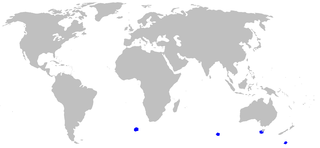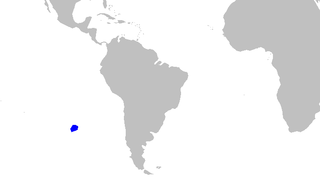
Scyliorhinidae is a family of sharks, one of a few families whose members share the common name catsharks, belonging to the order Carcharhiniformes, the ground sharks. Although they are generally known as catsharks, some species can also be called dogfish due to previous naming. However, a dogfish may generally be distinguished from a catshark as catsharks lay eggs while dogfish have live young. Like most bottom feeders, catsharks feed on benthic invertebrates and smaller fish. They are not harmful to humans. The family is paraphyletic, containing several distinct lineages that do not form a monophyletic group.

The Squaliformes are an order of sharks that includes about 126 species in seven families.
The Centrophoridae are a family of squaliform sharks. The family contains just two genera and about 15 species. They are sometimes called gulper sharks, but this is also the name of a specific species in the family, Centrophorus granulosus. These are generally deepwater fish. While some, such as the gulper shark C. granulosus, are found worldwide and fished commercially, others are uncommon and little-known. Their usual prey is other fish; some are known to feed on squid, octopus, and shrimp. Some species live on the bottom (benthic), while others are pelagic. They are ovoviviparous, with the female retaining the egg-cases in her body until they hatch.
Squalidae, more commonly known as dogfish, dog sharks, or spiny dogfish, are one of several families of sharks categorized under Squaliformes, making it the second largest order of sharks, numbering 119 species across 7 families. Having earned their name after a group of fishermen reportedly observed the species chasing down smaller fish in dog-like packs, dogfish have slender, streamlined bodies, usually more compact in comparison to other species, and a pointed snout. Dogfish likewise have two dorsal fins, each with smooth spines, but no anal fin, and their skin is generally rough to the touch. As the species reaches adulthood, males usually measure a maximum of 100 cm, while females typically measure 125 cm long. The species therefore exhibits female-dominant sexual dimorphism.
Deania is a genus of long-snouted, deepwater dogfish sharks in the family Centrophoridae.
Squalus is a genus of dogfish sharks in the family Squalidae. Commonly known as spurdogs, these sharks are characterized by smooth dorsal fin spines, teeth in upper and lower jaws similar in size, caudal peduncle with lateral keels; upper precaudal pit usually present, and caudal fin without subterminal notch. In spurdogs, the hyomandibula is oriented at a right angle to the neurocranium, while in other sharks, the hyomandibula runs more parallel to the body. This led some to think that the upper jaw of Squalus would not be as protractile as the jaws of other sharks. However, a study that compared different jaw suspension types in sharks showed that this is not the case and that Squalus is quite capable of protruding its upper jaw during feeding.

The Somniosidae are a family of sharks in the order Squaliformes, commonly known as sleeper sharks. The common name "sleeper shark" comes from their slow swimming, low activity level, and perceived non-aggressive nature.

The sherwood dogfish or Sherwood's dogfish is a very rare sleeper shark of the family Somniosidae, found only around New Zealand. The only specimen studied was about 80 cm long.

Cirrhigaleus is a genus of sharks in the Squalidae (dogfish) family, which is part of the Squaliformes order.

The viper dogfish or viper shark is a rare species of dogfish shark in the family Etmopteridae, and the only extant member of its genus. It has been found in the Pacific Ocean off southern Japan, the Bonin Islands, Pacific Ocean off northern Taitung County and the Northwestern Hawaiian Islands. This species inhabits upper continental slopes and seamounts. It may migrate vertically, shifting between bottom waters 270–360 m (890–1,180 ft) deep during the day and upper waters less than 150 m (490 ft) deep at night. A slender, black shark reaching 54 cm (21 in) in length, the viper dogfish can be recognized by its narrow, triangular jaws and well-spaced, fang-like teeth. It also has two spined dorsal fins, dermal denticles with faceted crowns, and numerous light-emitting photophores concentrated on its ventral surface.

The Portuguese dogfish or Portuguese shark, is a species of sleeper shark of the family Somniosidae. This globally distributed species has been reported down to a depth of 3,675 m (12,057 ft), making it the deepest-living shark known. It inhabits lower continental slopes and abyssal plains, usually staying near the bottom. Stocky and dark brown in color, the Portuguese dogfish can be distinguished from similar-looking species by the small spines in front of its dorsal fins. Its dermal denticles are also unusual, resembling the scales of a bony fish. This species typically reaches 0.9–1 m (3.0–3.3 ft) in length; sharks in the Mediterranean Sea are much smaller and have distinct depth and food preferences.
Centroscymnus is a genus of squaliform sleeper sharks in the family Somniosidae.
Scymnodon is a genus of squaliform sharks in the family Somniosidae.

The shortspine spurdog is a dogfish, a member of the family Squalidae, found on continental shelves off Japan in temperate waters, from the surface to 950 m. Its length is up to 75 cm.

The whitetail dogfish is a very rare sleeper shark of the family Somniosidae, found from the eastern Indian Ocean round southern Australia to New Zealand, at depths of between 150 and 500 m. Its length is up to 1.1 m.

The Azores dogfish is a very rare sleeper shark of the family Somniosidae. It is known only from the holotype caught north of the Azores and another caught in 2001.

The sparsetooth dogfish is a very rare sleeper shark of the family Somniosidae, the holotype of which was taken in the subtropical southeast Pacific at a depth of up to 200 m. Its biology is unknown.












